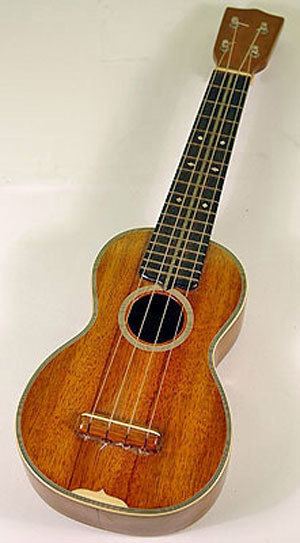 | ||
On a stringed instrument, a break in an otherwise ascending (or descending) order of string pitches is known as a re-entry. A re-entrant tuning, therefore, is a tuning where the strings (or more properly the courses) are not all ordered from the lowest pitch to the highest pitch (or vice versa).
Contents
Most common re-entrant tunings have only one re-entry. In the case of the soprano ukulele, for example, the re-entry is between the third and fourth strings, while in the case of the Venezuelan cuatro it is between the first and second strings.
Instruments
Instruments usually tuned in this way include:
Instruments often (but not always) re-entrantly tuned include:
Instruments not usually considered re-entrant, but which have common re-entrant alternate tunings:
The standard tunings for instruments with multi-string courses, such as the twelve string guitar, eight string bass, or Colombian tiple are not considered re-entrant, as the principal strings of each course are ordered from lowest to highest.
Ukulele
Ukuleles other than the tenor and baritone are most commonly tuned in re-entrant fashion. These conventional re-entrant tunings are sometimes known as high 4th tunings.
Non re-entrant tunings, also known as low 4th tunings, exist for these instruments.
Charango
The Andean charango, a small 5-course, 10-string guitar frequently made from an armadillo shell, is most usually tuned in re-entrant fashion, with re-entry between the third and second courses.
Other members of the charango family, such as the hualaycho and charangon are usually similarly tuned; the ronroco is often, but not always tuned re-entrantly.
Ten-string guitar
The ten string classical guitar was originally designed for a specific re-entrant tuning invented by Narciso Yepes, now called the Modern tuning. Both this and other re-entrant tunings, such as the Marlow tunings, are now used, as well as non re-entrant tunings such as the Baroque. These tunings may also be used on related instruments, such as ten string electric and jazz guitars.
Cuatro
The Venezuelan cuatro is a member of the guitar family, smaller in size and with four nylon strings. The cuatro is similar in size and construction to the ukulele and it is one of several South American instruments by the name of cuatro, which is Spanish for four. Despite of the name, not all instruments called Cuatro have four strings, but the Venezuelan Cuatro, preserves this number of strings.
The traditional "Camburpinton" tuning is re-entrant (A1–D2F♯2–B1), but with the re-entry between the second and first strings, rather than between third and fourth as in the ukulele. The results are very different in tone.
Other tunings of the Venezuelan cuatro are not re-entrant however they are not as popular as the "Camburpinton" tuning.
Note that there is also a 10-string/5-course Puerto Rican cuatro which is not tuned re-entrantly, but in straight fourths.
Tenor guitar
A variety of tunings are used for the four string tenor guitar, including a relatively small number of re-entrant tunings. One example of a re-entrant tuning for tenor guitar is D4–G3–B3–E4 with strings 3–1 as for the normal 6-string guitar, but string 4 tuned to D an octave above the 4th string of the 6 string guitar.
Banjo
The fifth string on the five string banjo, called the thumb string, also called the "drone string", is five frets shorter than the other four and is normally tuned higher than any of the other four, giving a re-entrant tuning such as the bluegrass G4-D3-G3-B3-D4. The five string banjo is particularly used in bluegrass music and old-time music.
The four string plectrum banjo (more often used in jazz), and the four string tenor banjo, lack this shorter string, and are rarely tuned in re-entrant fashion.
